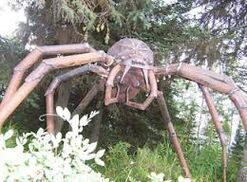
Most of the many anecdotal tales describe the spiders digging a shallow tunnel under tree roots and camouflaging it with a large bed of leaves. Then they create an almost invisible web between their burrow and a nearby tree, booby-trapping the whole thing with a network of trip lines. Some hapless creature—soon to end up on the menu—will trip the line alerting the spider. The victim will be chased into the web. This predatory entrapment is similar to some species of tarantula.
Presumably, the J'ba FoFi eggs are a pale yellow-white and shaped like peanuts. Native claim the hatchlings are bright yellow with a purple abdomen. Their coloration becomes darker and brown as they mature. Some of the natives indigenous to the regions in the Congo where the J'ba FoFi has been seen assert that the spider was once quite common, but has become very rare.
The fullest account by Westerners appears in a cryptozoological book by George Eberhart. On page 204, Eberhart relates the terrifying experience of an English couple traveling through a jungle region of what is now called the Congo: "R.K. Lloyd and his wife were motoring in the Belgium Congo in 1938 when they saw a large object crossing the trail in front of them. At first, they thought it was a cat or monkey, but they soon realized it was a spider with legs nearly 3 feet."
Famous naturalist and cryptozoologist, William J. Gibbons, has hunted for what some think may be a living African dinosaur called Mokele-mbembe. On his third expedition in search of the creature he came upon natives who related their experiences with giant spiders. He shared his experience with readers upon his return to Canada:
"On this third expedition to Equatorial Africa, I took the opportunity to inquire if the pygmies knew of such a giant spider, and indeed they did! They speak of the Jba Fofi, which is a "giant" or "great spider." They described a spider that is generally brown in color with a purple abdomen. They grow to quite an enormous size with a leg span of at least five feet. The giant arachnids weave together a lair made of leaves similar in shape to a traditional pygmy hut, and spin a circular web (said to be very strong) between two trees with a strand stretched across a game trail."
"These giant ground-dwelling spiders prey on the diminutive forest antelope, birds, and other small game, and are said to be extremely dangerous, not to mention highly venomous," Gibbons states. "The spiders are said to lay white, peanut-sized eggs in a cluster, and the pygmies give them a wide birth when encountered, but have killed them in the past. The giant spiders were once very common but are now a rare sight."
Many of the natives describe the spiders as once being numerous, but now a vanishing species. Encroachment by civilization in the form of rain forest being converted to farming may have driven the spiders from their natural habitats.
